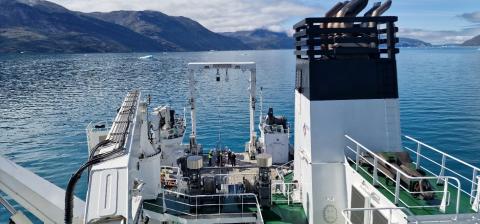
After successful sampling in the Igaliku Fjord, we headed to Ikersuaq fjord on Monday 24/07 in the evening. However, arriving at the mouth of the fjord, a long stretch of melting glacial ice was blocking our way inside. It was clear that the marine terminating glacier was losing too much ice to enter the fjord. Sampling would have been difficult anyway with all the drifting ice.
Fortunately, we had a plan B. The nearby Tunulliarfik fjord also has a marine terminating glacier and is discharging less ice for the moment. The transit early morning of the next day still remained a challenge. Fog and chunks of ice near the small town of Narsaq, where there is connection with the Ikersuaq fjord, were slowing us down over a distance of a few miles.
However, beyond Narsaq, the ice disappeared together with the fog. This inner part of the fjord was a place with magnificent views on the Greenlandic mountain peaks, landscapes shaped by the retreating glaciers, clear water and bright blue icebergs in all shapes and sizes. Again, we were lucky with the weather and again we could complete our program as scheduled for those days.
Still, since we did not sample the outer fjord yet, we had to return to the mouth, passing the ice-covered area around Narsaq. What we did not know, was how the ice situation would evolve in the time going out the fjord again, and knowing we had to return. We wanted to make sure we could finish our sampling programme, but also we have to take the plane from the Narsarsuaq airport at the uttermost inner part of this fjord. We need to leave the ship on the 3rd of August so that a new group of crew and scientists can replace us for the second part of the campaign.
Ice charts were promising and so was the weather forecast. We took our chance, deployed the lander in the inner fjord and left for the outer fjord again. And indeed most of the ice around Narsaq was gone and our passage went smoothly. Large parts of the fjord were almost ice-free now and we could successfully complete our transect from the shelf to the inner part. Clear gradients in temperature, salinity and phytoplankton were observed and the comparison with the Igaliku fjord can be made now.
During our transit we saw several whales from far; however one observation late in the evening was quite special. One Minky Whale was feeding by swimming the same route of a few 100 meters up and down the fjord, frequently jumping up with his head or diving deeper showing his typical small dorsal fin and tail. He didn’t pay any attention to the ship and gave us a nice evening spectacle, exactly the moment all our work of the day was finished.
Today we are sampling in the middle of the fjord, while for the next 3 days of our campaign we will finish our work in the inner fjord near the marine terminating glacier.